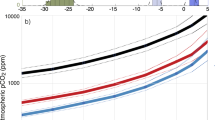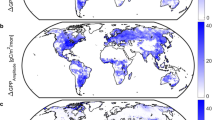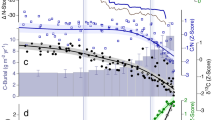Abstract
Environmental conditions during the past 24 million years are thought to have been favourable for enhanced rates of atmospheric carbon dioxide drawdown by silicate chemical weathering1,2,3,4,5,6,7. Proxy records indicate, however, that the Earth’s atmospheric carbon dioxide concentrations did not fall below about 200–250 parts per million during this period8. The stabilization of atmospheric carbon dioxide concentrations near this minimum value suggests that strong negative feedback mechanisms inhibited further drawdown of atmospheric carbon dioxide by high rates of global silicate rock weathering. Here we investigate one possible negative feedback mechanism, occurring under relatively low carbon dioxide concentrations and in warm climates, that is related to terrestrial plant productivity and its role in the decomposition of silicate minerals9,10,11. We use simulations of terrestrial and geochemical carbon cycles and available experimental evidence to show that vegetation activity in upland regions of active orogens was severely limited by near-starvation of carbon dioxide in combination with global warmth over this period. These conditions diminished biotic-driven silicate rock weathering and thereby attenuated an important long-term carbon dioxide sink. Although our modelling results are semi-quantitative and do not capture the full range of biogeochemical feedbacks that could influence the climate, our analysis indicates that the dynamic equilibrium between plants, climate and the geosphere probably buffered the minimum atmospheric carbon dioxide concentrations over the past 24 million years.
This is a preview of subscription content, access via your institution
Access options
Subscribe to this journal
Receive 51 print issues and online access
$199.00 per year
only $3.90 per issue
Buy this article
- Purchase on Springer Link
- Instant access to full article PDF
Prices may be subject to local taxes which are calculated during checkout



Similar content being viewed by others
References
Chung, S.-L. et al. Tibetan tectonic evolution inferred from spatial and temporal variations in post-collisional magmatism. Earth Sci. Rev. 68, 173–196 (2005)
Rowley, D. B. & Currie, B. S. Palaeo-altimetry of the late Eocene to Miocene Lunpola basin, central Tibet. Nature 439, 677–681 (2006)
DeCelles, P. G. et al. High and dry in central Tibet during the Late Oligocene. Earth Planet. Sci. Lett. 253, 389–401 (2007)
Gillis, R. J., Horton, B. K. & Grove, M. Thermochronology, geochronology, and upper crustal structure of the Cordillera Real: implications for Cenozoic exhumation of the central Andean plateau. Tectonics 25 10.1029/2005TC001887 (2006)
Blisniuk, P. M. & Stern, L. A. Stable isotope paleoaltimetry: a critical review. Am. J. Sci. 305, 1033–1074 (2005)
Garzione, C. N., Molnar, P., Libarkin, J. C. & MacFaden, B. J. Rapid late Miocene rise of the Bolivian altiplano: evidence for removal of mantle lithosphere. Earth Planet. Sci. Lett. 241, 543–556 (2006)
Reusch, D. N. & Maasch, K. A. in Tectonic Boundary Conditions for Climate Reconstruction (eds Crowley, T. J. & Burke, K. C.) 261–276 (Oxford Monographs on Geology and Geophysics, No. 38, Oxford University Press, 1998)
Pagani, M., Zachos, J. C., Freeman, K. H., Tipple, B. & Bohaty, S. Marked decline in atmospheric carbon dioxide concentrations during the Paleogene. Science 309, 600–603 (2005)
Moulton, K. L., West, J. & Berner, R. A. Solute flux and mineral mass balance approaches to the quantification of plant effects on silicate weathering. Am. J. Sci. 300, 539–570 (2000)
Andrews, J. A. & Schlesinger, W. H. Soil CO2 dynamics, acidification and chemical weathering in a temperate forest with experimental CO2 enrichment. Glob. Biogeochem. Cycles 15, 149–162 (2001)
Berner, E. K., Berner, R. A. & Moulton, K. L. Plants and mineral weathering: present and past. Treatise Geochem. 5, 169–188 (2003)
Zachos, J., Pagani, M., Sloan, L., Thomas, E. & Billups, K. Trends, rhythms, and aberrations in global climate: 65 Ma to present. Science 292, 686–693 (2001)
Pearson, P. N. & Palmer, M. R. Middle Eocene seawater pH and atmospheric carbon dioxide concentrations. Science 284, 824–826 (1999)
Kürschner, W. M., Kvacek, Z. & Dilcher, D. L. The impact of Miocene atmospheric carbon dioxide on climate and the evolution of terrestrial ecosystems. Proc. Natl Acad. Sci. USA 105, 449–453 (2008)
Berner, R. A. & Kothavala, Z. GEOCARB III: a revised model of atmospheric CO2 over Phanerozoic time. Am. J. Sci. 301, 182–204 (2001)
Cogné, J. & Humler, E. Trends and rhythms in global seafloor generation rate. Geochem. Geophys. Geosyst. 7 10.1029/2005GC001148 (2004)
Engebretson, D. C., Kelley, K. P., Cashman, H. J. & Richards, M. A. 180 million years of subduction. Geol. Soc. Am. Today 2, 93–95 (1992)
Lowenstein, T. K., Timofeff, M. N., Brennan, S. T., Hardie, L. A. & Demicco, R. V. Oscillations in Phanerozoic seawater chemistry: evidence from fluid inclusions. Science 294, 1086–1088 (2001)
Rowley, D. B. Rate of plate creation and destruction: 180 Ma to present. Geol. Soc. Am. Bull. 114, 927–933 (2002)
Kerrick, D. M. & Caldeira, K. Metamorphic CO2 degassing from orogenic belts. Chem. Geol. 145, 213–232 (1998)
Kerrick, D. M. & Caldeira, K. Was the Himalayan orogen a climatically significant coupled source and sink for atmospheric CO2 during the Cenozoic? Earth Planet. Sci. Lett. 173, 195–203 (1999)
Zeebe, R. E. & Calderia, K. Close mass balance of long-term carbon fluxes from ice-core CO2 and ocean chemistry records. Nature Geosci. 10.1038/ngeo185 (2008)
West, J., Galy, A. & Bickle, M. Tectonic and climatic controls on silicate weathering. Earth Planet. Sci. Lett. 235, 211–228 (2005)
Pearcy, R. W. & Ehleringer, J. Comparative ecophysiology of C3 and C4 plants. Plant Pop. Biol. 7, 1–13 (1984)
Ehleringer, J. R., Cerling, T. E. & Helliker, B. R. C4 photosynthesis, atmospheric CO2, and climate. Oecologia 112, 285–299 (1997)
Beerling, D. J. & Woodward, F. Vegetation and the Terrestrial Carbon Cycle; Modelling the First 400 Million Years (Cambridge University Press, 2001)
Jacobs, B. F., Kingston, J. D. & Jacobs, L. L. The origin of grass-dominated ecosystems. Ann. Missouri Bot. Garden 86, 90–643 (1999)
Taylor, L. L. et al. Biological weathering and the long-term carbon cycle: integrating mycorrhizal evolution and function into the current paradigm. Geobiology 7, 171–191 (2009)
Campbell, C. D., Sage, R. F., Kocacinar, F. & Way, D. A. Estimation of the whole-plant CO2 compensation point of tobacco (Nicotiana tabacum L.). Glob. Change Biol. 11, 1956–1967 (2005)
Lin, G. et al. Ecosystem carbon exchange in two terrestrial ecosystem mesocosms under changing atmospheric CO2 concentrations. Oecologia 119, 97–108 (1999)
Berner, R. A. GEOCARBSULF; a combined model for Phanerozoic atmospheric O2 and CO2 . Geochim. Cosmochim. Acta 70, 5653–5664 (2006)
Volk, T. Feedbacks between weathering and atmospheric CO2 over the last 100 million years. Am. J. Sci. 287, 763–779 (1987)
Farquhar, G. D., von Caemmerer, S. & Berry, J. A. A biochemical model of photosynthetic CO2 assimilation in leaves of C3 species. Planta 149, 78–90 (1980)
von Caemmerer, S. & Evans, J. R. Determination of the average partial pressure of CO2 in chloroplasts from leaves of several C3 plants. Aust. J. Plant Physiol. 18, 287–305 (1991)
Sharkey, T. D. Estimating the rate of photorespiration in leaves. Physiol. Plant. 73, 147–152 (1988)
Bernacchi, C. J., Singsaas, E. L., Pimentel, C., Portis, A. R. & Long, S. P. Improved temperature response functions for models of Rubisco-limited photosynthesis. Plant Cell Environ. 24, 253–259 (2001)
Woodward, F. I., Smith, T. M. & Emanuel, W. R. A global land primary productivity and phytogeography model. Glob. Biogeochem. Cycles 9, 471–490 (1995)
Parton, W. J. et al. Observations and modeling of biomass and soil organic matter dynamics for the grassland biome worldwide. Glob. Biogeochem. Cycles 7, 785–809 (1993)
Running, S. W. et al. A continuous satellite-derived measure of global terrestrial primary production. Bioscience 54, 547–560 (2004)
Hickler, T. et al. CO2 fertilization in temperate FACE experiments not representative of boreal and tropical forests. Glob. Change Biol. 14, 1–12 (2008)
Sitch, S. et al. Evaluation of the terrestrial carbon cycle, future plant geography and climate-carbon cycle feedbacks using five dynamic global vegetation models (SDGVMs). Glob. Change Biol. 14, 2015–2039 (2008)
Woodward, F. I. & Kelly, C. K. Responses of global plant diversity capacity to changes in carbon dioxide concentration and climate. Ecol. Lett. 11, 1229–1237 (2008)
Cowling, S. A. et al. Simulated glacial and interglacial vegetation across Africa: implications for species phylogenies and trans-African migration of plants and animals. Glob. Change Biol. 14, 827–840 (2008)
Cowling, S. A., Maslin, M. A. & Sykes, M. T. Paleovegetation simulations of lowland Amazonia and implications for neotropical allopatry and speciation. Quat. Res. 55, 140–149 (2001)
Acknowledgements
Conversations with C. Garzione, M. Hren. J. Berry, and C. Osborne were greatly appreciated. This work was supported, in part, by NSF grant OCE-0095734 (to M.P.) and DOE grant DE-FG02-01ER15173 (to R.A.B.). D.J.B. gratefully acknowledges funding from the Leverhulme Trust and Natural Environment Research Council (NE/E015190/1), and through a Royal Society-Wolfson Research Merit Award. M.P. acknowledges support from the Yale Climate and Energy Institute.
Author Contributions All four authors were involved in drafting the paper, led by M.P. K.C. and R.A.B. developed and applied procedures for modelling biotic weathering by land plants, and D.J.B. undertook the leaf-scale and global-scale simulations of vegetation processes.
Author information
Authors and Affiliations
Corresponding author
Supplementary information
Supplementary Figure
This file contains Supplementary Figure S1 with Legend. (PDF 167 kb)
Rights and permissions
About this article
Cite this article
Pagani, M., Caldeira, K., Berner, R. et al. The role of terrestrial plants in limiting atmospheric CO2 decline over the past 24 million years. Nature 460, 85–88 (2009). https://doi.org/10.1038/nature08133
Received:
Accepted:
Issue Date:
DOI: https://doi.org/10.1038/nature08133
This article is cited by
-
Hydrological control of river and seawater lithium isotopes
Nature Communications (2022)
-
The future lifespan of Earth’s oxygenated atmosphere
Nature Geoscience (2021)
-
Ocean Carbon Storage across the middle Miocene: a new interpretation for the Monterey Event
Nature Communications (2020)
-
A lower limit to atmospheric CO2 concentrations over the past 800,000 years
Nature Geoscience (2017)
-
Fossil proxies of near-shore sea surface temperatures and seasonality from the late Neogene Antarctic shelf
Naturwissenschaften (2013)
Comments
By submitting a comment you agree to abide by our Terms and Community Guidelines. If you find something abusive or that does not comply with our terms or guidelines please flag it as inappropriate.



